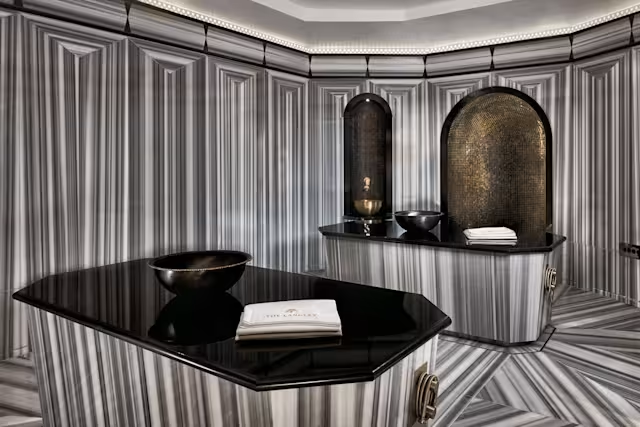Thermal spa treatments
Part of the Spabreaks.com Spa Treatment Guides
Spas are not just about touch treatments, they are also about other wellbeing experiences, and thermal suites can be one of the most enjoyable features. They help to prepare the body for therapies, provide a process that can be shared with friends, and give you time to really relax and unwind.

What is a thermal spa treatment?
A proper thermal suite is a combination of different areas, temperatures and levels of humidity, which are designed to take you on a journey that helps relax and cleanse the body, as well as prepare it for spa treatments. In many ways, a thermal suite is a spa treatment in itself. Types of thermal spa treatment
A thermal suite includes a variety of different heat and ice experiences designed to offer individual and collective wellbeing benefits. Elements broadly include:
- Sauna: This might be a Finnish sauna, dry sauna or infrared sauna, each using dry heat between 70° to 100° Celsius.
- Foot spas: Like Jacuzzis for your feet!
- Caldarium: A warm air room with an even heat radiating from the walls, floors and seats.
- Sanarium: A cleansing alternative to a traditional sauna with a temperature around 60°C.
- Experience showers: Used to rapidly heat or cool the body and stimulate the circulatory system.
- Tepidarium: Where heated, tiled loungers are designed to heat the body slowly before you move onto the hotter experiences.
- Aromatherapy crystal steam room: Infused with essential oils, often menthol, to aid respiration. Often these rooms are dark and the atmosphere enhanced by details such as lights set out like the stars.
- Salt steam room: A wet heat experience with salt added into the steam.
- Ice fountain/snow cave: Cold rooms or where you scrub ice over your skin from a ‘fountain’.
- Hydrotherapy pool: Often the central feature of a thermal suite/heat and ice experience, hydrotherapy pools are generally set at around 36 degrees to warm up the muscles and relax the body and mind.

What are the benefits of a thermal spa treatment?
Using thermal suite facilities before a spa treatment has been a longstanding recommendation of therapists in order to warm the muscles and prepare the skin for all the beautiful products to come, improving absorption and ultimately helping you to relax so that you get the most out of your treatment.
They also enhance wellbeing by raising and lowering the body temperature in a particular order. Benefits range from general wellbeing to relieving aches and pains, tension relief, soothing the skin, aiding respiration and sometimes helping with rheumatism and conditions like psoriasis. Individual features and their respective benefits may include:
- Sauna: Helps to eliminate toxins, clear the skin, remove dead skin cells, soothe muscles, improve circulation and boost the immune system.
- Foot spas: Help circulation and work on pressure points in the feet.
- Caldarium: Provides an even heat that stimulates circulation and regenerates the body’s natural energy. This effect has often been regarded as having healing benefits causing tense muscles to relax, making the skin smoother, and easing joint pain.
- Salt steam and crystal steam baths: Beneficial for the respiratory system and for rheumatic complaints. The salt steam has the added benefit of a salt water atmosphere, which is great for cleansing and toning the skin and stimulating the circulation.
- Sanarium: The unique blend of heat followed by a stimulating shower boosts the body’s natural defences and promotes circulation, shifting your metabolism up a gear. A Sanarium bath also cleanses the skin and tones the body tissue.
- Ice cave/fountain: Grab a few ladlefuls of ice and rub it over the skin to provide instant cooling. Mix in a cold shower in the ice cave and you will have truly cooled down, contracting your blood vessels, stimulating your circulation and oxygen intake at the same time.
What happens during a thermal spa treatment?
What happens during a thermal spa treatment? How you use a sauna or wider thermal suite is entirely up to you. It’s a self-controlled and self-administered process, which is one of the things lots of people like about it. It’s also a shared experience that can be enjoyed with friends. Depending on the facilities that the thermal suite has, this is a recommended journey:
- Firstly, it’s recommended that you use the facilities before having a spa treatment, so you can best prepare the skin and body to enjoy your therapy. Then leave products on your skin afterwards to work their magic.
- Then, start with a shower to remove all make-up, deodorants and perfume, and a warm foot bath to relax.
- Head to the lower temperatures of the caldarium for the recommended time.
- The sauna or sanarium will come next, depending on how hot you like it – you may wish to gradually work your way up.
- Cool down between each heat experience by taking a cool shower or using the ice fountain.
- After the sauna, spend a little time in the hydrotherapy pool and/or the tepidarium, then finish with the steam room before repeating the cycle.
- Remember to stay hydrated and don’t race through. You can take breaks between experiences and just enjoy the journey.
Choose this if you want to…
Thermal suites are great if you really relax the body and prepare the skin and muscles before a spa treatment. Thermal suites are also a perfect way to unwind and aid the healing process after a workout. We are often asked if thermal suites, and in particular Jacuzzis, are safe for pregnant women. Heat experiences are not recommended during pregnancy - you can find out more by looking at our pregnancy guide.

Average price of a thermal spa treatment
Thermal suites are generally included in the cost of a spa experience as part of the use of facilities. Some destinations with particularly extensive thermal suites will divide general leisure facilities (pool, sauna, steam room), from the dedicated thermal suite and there may be an additional cost for use and possibly dedicated time slots. The cost and specifics will vary from venue to venue.

Thermal spa aftercare
Thermal suites are cleansing experiences focused on heat, so you will definitely sweat and can become dehydrated. Make sure you drink plenty of water during and after your experience. If you want, you can replenish your skin with creams or oils afterwards - they will be absorbed much more easily after the heat. It’s advised that you spend time in the relaxation area and generally take it easy for the rest of the day. Try to avoid alcohol and caffeine for the remainder of the day or at least a few hours while you rehydrate and have something to eat.
What should I wear to a thermal spa treatment?
In the UK it’s common practice to wear swimwear in a thermal suite. You may also take a towel with you to sit or lie down on in saunas and steam rooms.
You Might Also Like

Saunas
Saunas are a wellbeing practice that have been used for many years in different cultures around the world. They are typically associated with Finnish and Estonian cultures, but are now fairly commonplace in gyms, spas and leisure facilities.
Read Our Guide
Hammam
Rooted in tradition, a hammam, is a Middle Eastern wellbeing practice that dates back to the Roman and Byzantine eras and is essentially a steam bath experience that can be shared with other people.
Read our guide
Rhassoul and mud treatments
Mud baths, rhassouls/rasuls and mud treatments come in a number of different guises, and have been cleansing and healing practices for thousands of years. Introduced to different cultures around the world with their own variations, but largely operating on the same theme.
Read our guide